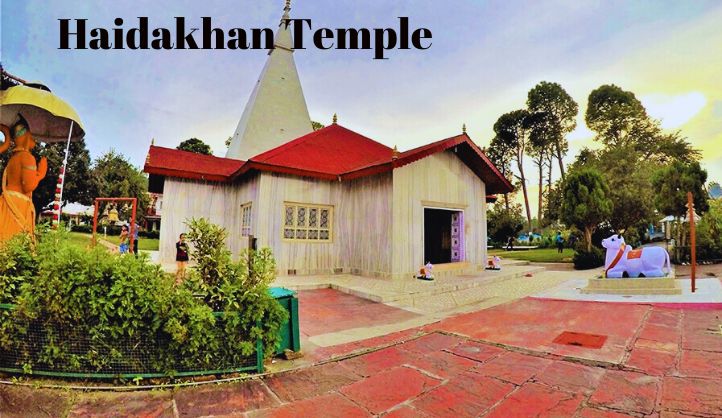Perched atop the serene hills of the Kumaon region in Uttarakhand, India, the Haidakhan Temple in Ranikhet stands as a revered sanctuary of spiritual solace and divine energy. This ancient temple, dedicated to the divine figure of Haidakhan Baba, attracts devotees and seekers from all corners of the world seeking spiritual guidance, peace, and blessings. In this detailed exploration, we delve into the rich history, cultural significance, spiritual teachings, architectural marvels, and the tranquil ambiance that defines the Haidakhan Temple Ranikhet.
Discovering the Essence of Haidakhan Baba
Origins and Legacy
The story of Haidakhan Baba, also known as Babaji or simply Babaji Maharaj, begins with the manifestation of a divine being in the hills of Uttarakhand in the early 20th century. Believed to be an incarnation of Lord Shiva, Babaji’s teachings emphasized simplicity, love, selfless service, and devotion to God. His profound wisdom and miraculous deeds quickly attracted followers, who regarded him as a living saint and spiritual guide.
The Haidakhan Temple itself holds significance as the place where Babaji spent a significant part of his life, imparting spiritual teachings and guiding his disciples. His teachings emphasized the unity of all religions and the universal nature of spirituality, transcending boundaries of caste, creed, and nationality.
Spiritual Teachings and Philosophy
Central to Babaji’s teachings were the principles of karma yoga (selfless service), bhakti yoga (devotion), and jnana yoga (knowledge). He emphasized the importance of leading a righteous life, practicing meditation, chanting mantras, and serving humanity with love and compassion. The Haidakhan Temple serves as a spiritual center where devotees come to meditate, participate in prayers (arti), and seek guidance on their spiritual journeys.
Babaji’s teachings are preserved through his recorded discourses, known as “Babaji’s Satsangs,” which continue to inspire seekers toward self-realization and spiritual awakening. His messages of peace, unity, and love resonate deeply within the hearts of his followers, fostering a global community dedicated to spreading his teachings.
How to reach it
By Air
The nearest airport to Haidakhan Temple is Pantnagar Airport, approximately 115 kilometers away. From Pantnagar Airport, you can reach Ranikhet by taxi or private car. The journey from Pantnagar to Ranikhet takes approximately 3-4 hours depending on traffic and road conditions.
By Train
The nearest railway station to Haidakhan Temple is Kathgodam Railway Station, From Kathgodam, you can hire a taxi or take a bus to Ranikhet, which is about 75 kilometers away and takes around 2-3 hours by road.
By Road
If arriving by train at Kathgodam, you can hire a taxi or take a bus to Ranikhet. From Ranikhet, Haidakhan Temple is a short drive away. From Ranikhet, Haidakhan Temple is situated in Chilyanaula village, which is about 4 kilometers away. You can hire a taxi or take a local bus from Ranikhet bus stand to reach the temple.
Map of Haidakhan Temple
Architectural Splendor and Sacred Spaces
Temple Complex and Surroundings
The Haidakhan Temple complex is a testament to both simplicity and spiritual grandeur. Situated amidst lush greenery and commanding views of the Himalayan peaks, the temple radiates an aura of peace and tranquility. The main temple structure is built in traditional Indian architectural style, adorned with intricate carvings and embellishments that reflect spiritual symbolism and reverence.
Within the temple complex, various sacred spaces draw pilgrims and visitors seeking blessings and spiritual healing. The central shrine houses the samadhi (final resting place) of Haidakhan Baba, where devotees offer prayers and floral tributes. Surrounding the main shrine are smaller temples dedicated to different deities, including Lord Shiva, Goddess Kali, Lord Hanuman, and others, reflecting the temple’s inclusive approach to religious worship.
Meditation Halls and Ashram Facilities
Adjacent to the temple, meditation halls provide serene environments for practitioners to engage in silent meditation and spiritual contemplation. The ashram facilities accommodate devotees and pilgrims who wish to stay and immerse themselves in the temple’s spiritual atmosphere. The ashram also offers simple accommodations, vegetarian meals, and opportunities to participate in daily rituals and spiritual activities.
Rituals and Festivals
Daily Rituals and Ceremonies
The Haidakhan Temple follows a daily schedule of rituals and ceremonies that uphold the traditions and spiritual practices established by Babaji. The day begins with the morning arati (worship ceremony), during which priests chant Vedic hymns and offer prayers to the deities. Devotees participate in these rituals, seeking blessings for health, prosperity, and spiritual growth.
Major Festivals and Celebrations
Throughout the year, the temple celebrates various festivals that hold cultural and religious significance. The Maha Shivaratri festival, dedicated to Lord Shiva, is observed with great reverence and devotion. Devotees gather to perform special prayers, recite sacred mantras, and participate in a night-long vigil (Jagran) to honor Lord Shiva. Other festivals such as Navratri, Diwali, and Guru Purnima are also celebrated with enthusiasm, marking occasions of spiritual significance and community bonding.
Pilgrimage and Spiritual Tourism
Pilgrimage Experience
For pilgrims and spiritual tourists, visiting the Haidakhan Temple is a transformative journey that offers opportunities for introspection, renewal, and spiritual awakening. The serene surroundings and the divine presence of Babaji’s samadhi evoke a sense of peace and inner calm, making it an ideal retreat for meditation and self-reflection.
Spiritual Practices and Retreats
The temple organizes spiritual retreats, meditation camps, and yoga sessions throughout the year, inviting participants to deepen their spiritual practices and connect with like-minded seekers. These retreats often include guided meditation sessions, spiritual discourses, and opportunities for personal growth under the guidance of experienced spiritual teachers and gurus associated with the temple.
Nearby places you can explore
1. Ranikhet
- Jhula Devi Temple: Located in Ranikhet, this Jhula Devi Temple ancient temple is dedicated to Goddess Durga. It is famous for its large number of bells offered by devotees over the years, believed to fulfill wishes.
- Chaubatia Gardens: Known for its orchards of apples, peaches, apricots, and almonds, Chaubatia Gardens also offers panoramic views of the Himalayas. It’s a great spot for a stroll amidst nature.
- Upat Golf Course: Situated amidst picturesque surroundings, the Upat Golf Course in Ranikhet is one of the highest golf courses in Asia. It offers stunning views of the snow-capped Himalayan peaks and is open to visitors.
2. Kausani
- Baijnath Temple: Located in Kausani, this ancient temple complex is dedicated to Lord Shiva and Parvati. It is renowned for its intricate stone carvings and spiritual significance.
- Anasakti Ashram (Gandhi Ashram): This ashram is where Mahatma Gandhi stayed for a brief period in 1929. It offers panoramic views of the Himalayas and serves as a serene retreat for meditation and reflection.
3. Almora
- Bright End Corner: A popular viewpoint in Almora offering breathtaking views of the sunrise and sunset over the Himalayas. It’s an ideal spot for photography enthusiasts and nature lovers.
- Kasar Devi Temple: Known for its historical significance and spiritual aura, Kasar Devi Temple attracts both tourists and spiritual seekers. It offers panoramic views of the surrounding valleys.
4. Binsar
- Binsar Wildlife Sanctuary: Binsar Wildlife Sanctuary is famous for its rich biodiversity, including rare species of flora and fauna. The sanctuary offers trekking trails amidst dense oak and rhododendron forests.
- Binsar Zero Point: A viewpoint that offers stunning panoramic views of the Himalayan peaks including Nanda Devi, Trishul, and Panchachuli. It’s a must-visit for nature enthusiasts and adventure seekers.
5. Nainital
- Naini Lake: The heart-shaped lake at the center of Nainital offers boating and scenic views. The surrounding Mall Road is lined with shops, restaurants, and cafes.
- Naina Devi Temple: Located on the northern shore of Naini Lake, this temple is dedicated to Goddess Naina Devi. It is a prominent pilgrimage site and offers serene surroundings for prayers and meditation.
6. Mukteshwar
- Chauli Ki Jali: A Chauli Ki Jali natural rock formation with mythological significance, offering panoramic views of the valley. It’s a popular spot for adventure activities like rock climbing and rappelling.
- Mukteshwar Temple: A Mukteshwar Temple ancient temple dedicated to Lord Shiva, situated atop a hill with panoramic views of the Himalayan ranges. It’s a serene place for spiritual contemplation and meditation.
Conclusion
In conclusion, the Haidakhan Temple in Ranikhet stands as a timeless sanctuary where spirituality, devotion, and community service converge to create a harmonious environment for seekers of truth and inner peace. Its majestic surroundings, profound teachings of Haidakhan Baba, and vibrant spiritual practices inspire visitors to embark on a journey of self-discovery and spiritual enlightenment.
Whether you are drawn to its sacred rituals, architectural splendor, or the transformative power of meditation, a visit to the Haidakhan Temple promises a profound spiritual experience amidst the tranquil beauty of the Himalayan foothills. As you immerse yourself in its sacred ambiance, may you find solace, wisdom, and divine blessings that resonate deeply within your heart and soul.
FAQs About Haidakhan Temple, Ranikhet
1. What is the Haidakhan Temple?
The Haidakhan Temple, located near Ranikhet in Uttarakhand, India, is a revered spiritual center dedicated to Haidakhan Baba (also known as Babaji Maharaj). It is believed that Haidakhan Baba, considered an incarnation of Lord Shiva, lived and imparted spiritual teachings in this region during the early 20th century. The temple houses his samadhi (final resting place) and is a place of pilgrimage for devotees seeking spiritual guidance and blessings.
2. Where is Haidakhan Temple located?
Haidakhan Temple is situated in Chilyanaula village, about 4 kilometers from Ranikhet town, in the Almora district of Uttarakhand, India. It is nestled amidst the serene hills of the Kumaon region, offering a tranquil setting conducive to meditation and spiritual contemplation.
3. What are the teachings of Haidakhan Baba?
Haidakhan Baba’s teachings revolve around the principles of karma yoga (selfless service), bhakti yoga (devotion), and jnana yoga (knowledge). He emphasized the importance of leading a righteous life, practicing meditation, chanting mantras, and serving humanity with love and compassion. His teachings emphasize unity among all religions and the universal nature of spirituality.
4. What are the main attractions at Haidakhan Temple?
The main attractions at Haidakhan Temple include:
- Samadhi Shrine: The sacred place where Haidakhan Baba’s physical remains are interred, attracting devotees who seek his blessings.
- Main Temple Structure: Built in traditional Indian architectural style, adorned with intricate carvings and spiritual symbolism.
- Meditation Halls: Serene spaces for meditation and spiritual practices, offering a peaceful atmosphere for introspection.
- Surrounding Natural Beauty: Majestic views of the Himalayan peaks and lush greenery, enhancing the spiritual ambiance of the temple.
5. What are the rituals performed at Haidakhan Temple?
The temple follows a daily schedule of rituals and ceremonies that include morning and evening arati (worship ceremonies), chanting of Vedic hymns, and offerings of flowers and sacred items to the deities. Devotees participate in these rituals to seek blessings for health, prosperity, and spiritual well-being.





